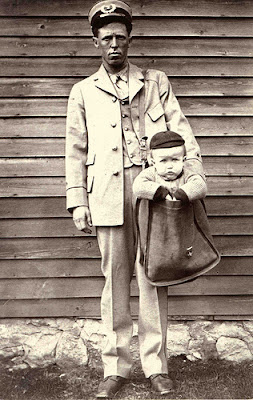The other day I read this at the end of someone's email:
It is perfectly fine to print this email. Paper is a biodegradable, renewable, sustainable product made from trees. Growing and harvesting trees provides jobs for millions of men and women. Working forests are good for the environment, providing clean air, clean water, wildlife habitat and carbon storage. When you don't need it anymore, be sure to put it in a bin designated for recycling, and it will come back as new paper!
And it started me wondering. Can printing and direct mail actually be good for the environment? I had to check it out.
I learned that only about 14% of the 3.3 billion cubic meters of wood consumed worldwide each year is for paper production and much of this wood comes from wood chips and other "leftovers" from sawmill operations. On the other hand, over half of the wood harvested in the world is used for fuel, mostly for cooking and domestic heating. The second-largest wood use is for lumber and plywood in home building.
Of course, some of our paper is made from trees (and not wood by-products), but not from old-growth forests. These days, tree farms are planted and grown specifically for paper, just like any other crop. As one area of trees is harvested, another is planted in a cycling, continuous-growth farm.
Thanks to these sustainable practices, the amount of forests has grown significantly in recent years. We have more forests in the U.S. now than we did 50 years ago, and about the same forestland as we did 100 years ago (U.S. Forest Resource Facts and Historical Trends). Put another way: our use of paper has convinced tree farmers that it's a worthwhile crop.
It is perfectly fine to print this email. Paper is a biodegradable, renewable, sustainable product made from trees. Growing and harvesting trees provides jobs for millions of men and women. Working forests are good for the environment, providing clean air, clean water, wildlife habitat and carbon storage. When you don't need it anymore, be sure to put it in a bin designated for recycling, and it will come back as new paper!
And it started me wondering. Can printing and direct mail actually be good for the environment? I had to check it out.
I learned that only about 14% of the 3.3 billion cubic meters of wood consumed worldwide each year is for paper production and much of this wood comes from wood chips and other "leftovers" from sawmill operations. On the other hand, over half of the wood harvested in the world is used for fuel, mostly for cooking and domestic heating. The second-largest wood use is for lumber and plywood in home building.
Of course, some of our paper is made from trees (and not wood by-products), but not from old-growth forests. These days, tree farms are planted and grown specifically for paper, just like any other crop. As one area of trees is harvested, another is planted in a cycling, continuous-growth farm.
Thanks to these sustainable practices, the amount of forests has grown significantly in recent years. We have more forests in the U.S. now than we did 50 years ago, and about the same forestland as we did 100 years ago (U.S. Forest Resource Facts and Historical Trends). Put another way: our use of paper has convinced tree farmers that it's a worthwhile crop.
You might say that not using paper to "save a tree" is like not eating your greens to save a vegetable.
If "saving trees" isn't an issue, why bother recycling paper at all? To save landfill space. Plus, paper is easy and inexpensive to recycle. It can be remade into products like corrugated boxes, packaging, newsprint, tissue and new paper. According to the EPA, direct mail currently accounts for only 2.4% of landfill waste; and the recycling recovery rate of direct mail has grown nearly 700% since 1990.
None of us likes to be wasteful, so here are some effective ways to help the environment in your next direct mail campaign: Target your mailing to avoid mailing to prospects with a lower likelihood of response. Keep your mailing list up to date, and pass it through NCOA (National Change of Address) regularly. Ask your printer to use vegetable or soy-based inks (shameless plug: Post Haste Direct Mailing already uses these) rather than petroleum-based inks. Use recycled paper or paper produced through responsible forestry.
So go ahead and print that email. Or this blog article. And feel good knowing you're saving a tree.
For more information on Post Haste Mailing Services, visit www.posthastemailing.com, or email us at: info@posthastemailing.comIf "saving trees" isn't an issue, why bother recycling paper at all? To save landfill space. Plus, paper is easy and inexpensive to recycle. It can be remade into products like corrugated boxes, packaging, newsprint, tissue and new paper. According to the EPA, direct mail currently accounts for only 2.4% of landfill waste; and the recycling recovery rate of direct mail has grown nearly 700% since 1990.
None of us likes to be wasteful, so here are some effective ways to help the environment in your next direct mail campaign: Target your mailing to avoid mailing to prospects with a lower likelihood of response. Keep your mailing list up to date, and pass it through NCOA (National Change of Address) regularly. Ask your printer to use vegetable or soy-based inks (shameless plug: Post Haste Direct Mailing already uses these) rather than petroleum-based inks. Use recycled paper or paper produced through responsible forestry.
So go ahead and print that email. Or this blog article. And feel good knowing you're saving a tree.












